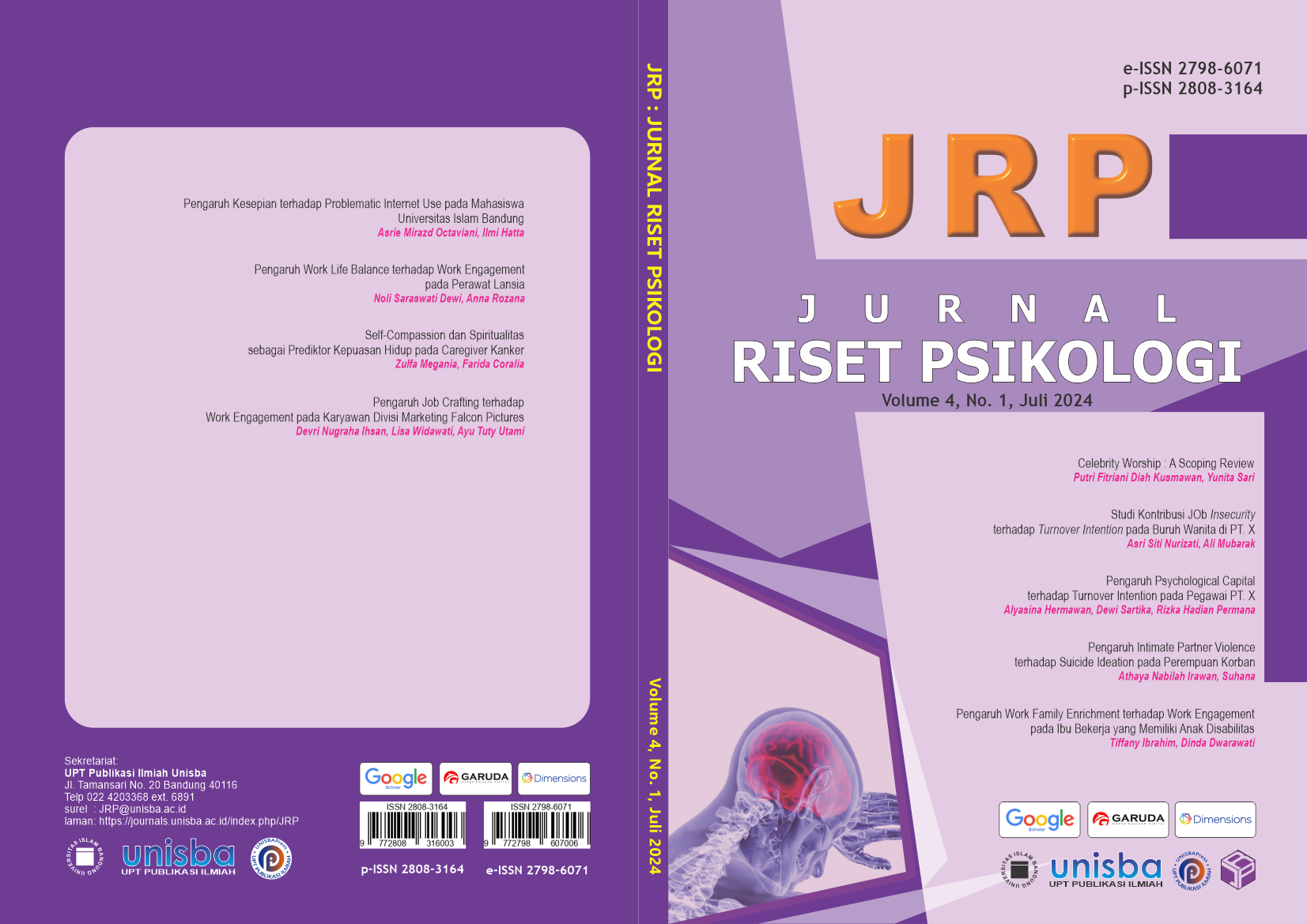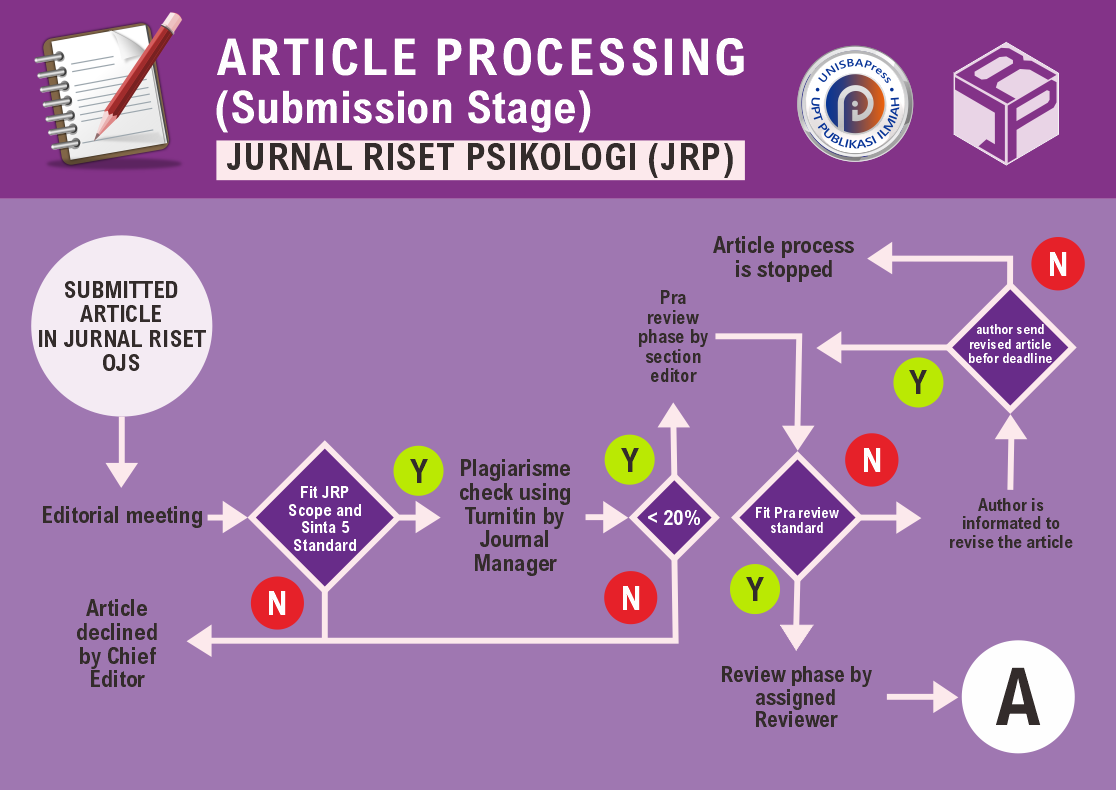Pengaruh Kesepian terhadap Problematic Internet Use pada Mahasiswa Universitas Islam Bandung
DOI:
https://doi.org/10.29313/jrp.v4i1.3885Keywords:
Loneliness, Problematic Internet Use, StudentAbstract
Abstract. Nowadays, internet use is something that is difficult to separate from everyday life. The internet can provide benefits, anyone can easily access various information and communicate anytime and anywhere. However, this convenience can have a negative impact if internet use is carried out intensively and excessively because it can lead to Problematic Internet Use (PIU). Individuals who feel lonely tend to access more time on the internet to build friendships and overcome negative feelings of loneliness by interacting online. This study aims to examine how much influence loneliness has on PIU among students at Bandung Islamic University. The measuring tool used is the Generalized Problematic Internet Use Scale 2 (GPIUS2), while to measure loneliness the UCLA Loneliness Scale Version 3 is used which has been adapted into Indonesian. This research uses causality research methods and data analysis using a simple linear regression test. The research results show that the R square (R2) coefficient of determination is 0.276, which means that the loneliness variable influences the PIU variable by 27.6%.
Abstrak. Penggunaan internet di masa sekarang merupakan hal yang sulit terpisahkan dari kehidupan sehari-hari. Internet dapat memberikan keuntungan, siapa saja dapat dengan mudah mengakses berbagai informasi dan berkomunikasi kapan pun dan di mana pun. Namun, dengan kemudahan tersebut dapat berdampak buruk jika penggunaan internet dilakukan secara intensif dan berlebihan karena dapat mengarah pada terjadinya Problematic Internet Use (PIU). Individu yang merasa kesepian cenderung mengakses lebih banyak waktu di internet untuk membangun pertemanan dan mengatasi perasaan negatif dari kesepian tersebut dengan berinteraksi secara online. Penelitian ini bertujuan untuk menguji seberapa besar pengaruh kesepian terhadap PIU pada mahasiswa Universitas Islam Bandung. Alat ukur yang digunakan adalah Generalized Problematic Internet Use Scale 2 (GPIUS2), sedangkan untuk mengukur kesepian digunakan UCLA Loneliness Scale Version 3 yang telah diadaptasi ke dalam bahasa Indonesia. Penelitian ini menggunakan metode penelitian kausalitas dan analisis data menggunakan uji regresi linier sederhana. Hasil penelitian menunjukkan bahwa nilai R square (R2) koefisien determinasi sebesar 0.276 yang artinya varibel kesepian mempengaruhi variabel PIU sebesar 27.6%.
References
R. A. Davis, “A cognitive-behavioral model of pathological Internet use,” Comput Human Behav, vol. 17, no. 2, pp. 187–195, Mar. 2001, doi: 10.1016/S0747-5632(00)00041-8.
S. Caplan, D. Williams, and N. Yee, “Problematic Internet use and psychosocial well-being among MMO players,” Comput Human Behav, vol. 25, no. 6, pp. 1312–1319, Nov. 2009, doi: 10.1016/j.chb.2009.06.006.
B. C. Banz, S. W. Yip, Y. H. C. Yau, and M. N. Potenza, “Behavioral addictions in addiction medicine,” 2016, pp. 311–328. doi: 10.1016/bs.pbr.2015.08.003.
S. E. Caplan, “Problematic Internet use and psychosocial well-being: development of a theory-based cognitive–behavioral measurement instrument.,” Comput Human Behav, vol. 18, no. 2, pp. 553–575, 2002.
S. Azwar, Penyusunan Skala Psikologi. Pustaka Pelajar, 2010.
G. P. Riyanto, “Orang Indonesia Internetan Lebih dari 7 Jam Sehari, Paling Sering Buka WA dan IG,” Kompas.com. Accessed: Jul. 16, 2024. [Online]. Available: https://tekno.kompas.com/read/2023/02/14/14020097/orang-indonesia-internetan-lebih-dari-7-jam-sehari-paling-sering-buka-wa-dan-ig
L. A. Peplau and D. Perlman, “Kesepian: A Sourcebook of Current Theory, Research and Therapy,” 1982.
A. S. Widodo, “Peran Internet dalam Meningkatkan Jumlah Pekerja Lepas di Indonesia,” Nyimak:Journal of Communication, vol. 3, no. 2, pp. 191–202, 2019.
S. Hia and S. Ginting, “Pengaruh internet terhadap prestasi belajar mahasiswa fakultas ekonomi dan ilmu sosial Universitas Sari Mutiara Indonesia kota Medan,” Jurnal Lensa Mutiara Komunikasi, vol. 2, no. 1, pp. 61–77, 2018.
M. R. Rinaldi, “Kesepian pada Mahasiswa selama Pandemi COVID-19 di Indonesia,” Jurnal Psikologi Teori dan Terapan, vol. 11, no. 3, p. 267, Jul. 2021, doi: 10.26740/jptt.v11n3.p267-277.
S. Fitri, “DAMPAK POSITIF DAN NEGATIF SOSIAL MEDIA TERHADAP PERUBAHAN SOSIAL ANAK,” NATURALISTIC : Jurnal Kajian Penelitian Pendidikan dan Pembelajaran, vol. 1, no. 2, pp. 118–123, Apr. 2017, doi: 10.35568/naturalistic.v1i2.5.
H. Odacı and M. Kalkan, “Problematic Internet use, loneliness and dating anxiety among young adult university students,” Comput Educ, vol. 55, no. 3, pp. 1091–1097, Nov. 2010, doi: 10.1016/j.compedu.2010.05.006.
E. S. Risi, S. M. Abdullah, and Rinaldi M.R., “Kesepian dan Penggunaan Internet Bermasalah pada Mahasiswa,” Jurnal RAP (Riset Aktual Psikologi Universitas Negeri Padang), vol. 11, no. 2, pp. 228–238, 2020.
C. Cheng and A. Y. Li, “Internet Addiction Prevalence and Quality of (Real) Life: A Meta-Analysis of 31 Nations Across Seven World Regions,” Cyberpsychol Behav Soc Netw, vol. 17, no. 12, pp. 755–760, Dec. 2014, doi: 10.1089/cyber.2014.0317.
T. Marci, C. Marino, C. Sacchi, X. Lan, and M. M. Spada, “Problematic Internet Use in early adolescence: The role of attachment and negative beliefs about worry,” J Behav Addict, vol. 10, no. 1, pp. 194–200, Apr. 2021, doi: 10.1556/2006.2021.00001.
R. A. Baron and D. Byrne, Psikologi Sosial, 10th ed. Erlangga, 2005.
R. Reynaldo and Y. A. Sokang, “Mahasiswa dan Internet: Dua Sisi Mata Uang? Problematic Internet Use pada Mahasiswa,” Jurnal Psikologi, vol. 43, no. 2, p. 107, Jun. 2016, doi: 10.22146/jpsi.17276.
APJII, Profil internet indonesia 2022. Jakarta : CSR Consulting, 2022.
J. T. Cacioppo, M. E. Hughes, L. J. Waite, L. C. Hawkley, and R. A. Thisted, “Loneliness as a specific risk factor for depressive symptoms: Cross-sectional and longitudinal analyses.,” Psychol Aging, vol. 21, no. 1, pp. 140–151, Mar. 2006, doi: 10.1037/0882-7974.21.1.140.
L. Quadt, G. Esposito, H. D. Critchley, and S. N. Garfinkel, “Brain-body interactions underlying the association of loneliness with mental and physical health,” Neurosci Biobehav Rev, vol. 116, pp. 283–300, Sep. 2020, doi: 10.1016/j.neubiorev.2020.06.015.
J. Skues, B. Williams, J. Oldmeadow, and L. Wise, “The Effects of Boredom, Loneliness, and Distress Tolerance on Problem Internet Use Among University Students,” Int J Ment Health Addict, vol. 14, no. 2, pp. 167–180, Apr. 2016, doi: 10.1007/s11469-015-9568-8.
Into The Light Indonesia, “Seri Laporan ke-1: Laporan Perilaku Penggunaan Layanan Kesehatan Mental di Indonesia 2021 – Hasil Awal,” Into The Light Indonesia. Accessed: Jul. 16, 2024. [Online]. Available: htttps://www.intothelightid.org/tentang-bunuh-diri/laporan-perilaku-penggunaan-layanan-kesehatan-mental-di-indonesia-2021-hasil-awal/
Y. Maulidi and A. Budiman, “HUBUNGAN KESEPIAN DENGAN KECANDUAN GAME ONLINE PADA MAHASISWA DI KOTA BANDUNG,” Prosiding Psikologi, vol. 6, no. 2, Jul. 2020.
Md. S. Akhter, M. H. Islam, and Md. N. Momen, “Problematic Internet Use among university students of Bangladesh: The predictive role of age, gender, and loneliness,” J Hum Behav Soc Environ, vol. 30, no. 8, pp. 1082–1093, Nov. 2020, doi: 10.1080/10911359.2020.1784346.
H. Alheneidi, L. AlSumait, D. AlSumait, and A. P. Smith, “Loneliness and Problematic Internet Use during COVID-19 Lock-Down,” Behavioral Sciences, vol. 11, no. 1, p. 5, Jan. 2021, doi: 10.3390/bs11010005.
H. Odacı and Ç. B. Çelik, “Who are problematic internet users? An investigation of the correlations between problematic internet use and shyness, loneliness, narcissism, aggression and self-perception,” Comput Human Behav, vol. 29, no. 6, pp. 2382–2387, Nov. 2013, doi: 10.1016/j.chb.2013.05.026.
P. Reed, A. Davies, K. Evans, and L. A. Osborne, “Longitudinal relationship between problematic internet use with loneliness during and after COVID-19 social restrictions,” Psychiatry Res, vol. 323, p. 115148, May 2023, doi: 10.1016/j.psychres.2023.115148.
M. Muliati, N. Aiyuda, and I. N. Nasution, “Loneliness but Narcissistic!,” Jurnal Riset Psikologi, pp. 79–84, Dec. 2022, doi: 10.29313/jrp.v2i2.1595.
A. R. Hakim, “Penanganan Problematic Internet Use (PIU) pada Anak Pre-Adolesecent degan Metode Peer Tutorial.,” Universitas Muhammadiyah Malang, Malang, 2018.
W. D. S. Killgore, S. A. Cloonan, E. C. Taylor, M. A. Miller, and N. S. Dailey, “Three months of loneliness during the COVID-19 lockdown,” Psychiatry Res, vol. 293, p. 113392, Nov. 2020, doi: 10.1016/j.psychres.2020.113392.
Tim CNN Indonesia, “Studi: 1 dari 3 Orang Dewasa Muda Mengalami Kesepian,” CNN Indonesia. Accessed: Jul. 16, 2024. [Online]. Available: https://www. indonesia.com/gaya-hidup/20191216162634-255-457435/studi-1-dari-3-orang-dewasa-muda-alami-kesepian
P. S. A. Govinda and Y. Hanami, “Pengalaman Intercultural Adjustment Mahasiswa Indonesia di Jepang,” Jurnal Psikologi Islam dan Budaya, vol. 6, no. 1, pp. 01–20, May 2023, doi: 10.15575/jpib.v6i1.23613.
S. E. Caplan, “Theory and measurement of generalized problematic Internet use: A two-step approach,” Comput Human Behav, vol. 26, no. 5, pp. 1089–1097, Sep. 2010, doi: 10.1016/j.chb.2010.03.012.
E. W. Andangsari and B. Dhowi, “Two Typology Types of Loneliness and Problematic Internet Use (PIU): An Evidence of Indonesian Measurement,” Adv Sci Lett, vol. 22, no. 5, pp. 1711–1714, May 2016, doi: 10.1166/asl.2016.6740.
D. W. Russell, “UCLA Loneliness Scale (Version 3): Reliability, Validity, and Factor Structure,” J Pers Assess, vol. 66, no. 1, pp. 20–40, Feb. 1996, doi: 10.1207/s15327752jpa6601_2.
J. Hudiyana et al., “How Universal Is a Construct of Loneliness? Measurement Invariance of the UCLA Loneliness Scale in Indonesia, Germany, and the United States,” Assessment, vol. 29, no. 8, pp. 1795–1805, Dec. 2022, doi: 10.1177/10731911211034564.
Y.-J. Kim, D. Roh, S.-K. Lee, F. Canan, and M. N. Potenza, “Factors Statistically Predicting At-Risk/Problematic Internet Use in a Sample of Young Adolescent Boys and Girls in South Korea,” Front Psychiatry, vol. 9, Aug. 2018, doi: 10.3389/fpsyt.2018.00351.
E. Ningsih, “Hubungan Loneliness dan Intensitas Penggunaan Media Sosial pada Mahasiswa,” Universitas Islam Riau, Riau, 2021.
T. Moretta and G. Buodo, “Problematic Internet Use and Loneliness: How Complex Is the Relationship? A Short Literature Review,” Curr Addict Rep, vol. 7, no. 2, pp. 125–136, Jun. 2020, doi: 10.1007/s40429-020-00305-z.
B. Fernandes et al., “Internet use during COVID-19 lockdown among young people in low- and middle-income countries: Role of psychological wellbeing,” Addictive Behaviors Reports, vol. 14, p. 100379, Dec. 2021, doi: 10.1016/j.abrep.2021.100379.
L. A. Peplau and D. Perlman, “Blueprint for a Social Psychological Theory of Loneliness,” 1979.
D. Russell, L. A. Peplau, and C. E. Cutrona, “The revised UCLA Loneliness Scale: Concurrent and discriminant validity evidence.,” J Pers Soc Psychol, vol. 39, no. 3, pp. 472–480, Sep. 1980, doi: 10.1037/0022-3514.39.3.472.
S. Azwar, Reliabilitas dan Validitas. Pustaka Pelajar, 2010.
S. Casale, S. E. Caplan, and G. Fioravanti, “Positive metacognitions about Internet use: The mediating role in the relationship between emotional dysregulation and problematic use,” Addictive Behaviors, vol. 59, pp. 84–88, Aug. 2016, doi: 10.1016/j.addbeh.2016.03.014.
R. LaRose, C. A. Lin, and M. S. Eastin, “Unregulated Internet Usage: Addiction, Habit, or Deficient Self-Regulation?,” Media Psychol, vol. 5, no. 3, pp. 225–253, Aug. 2003, doi: 10.1207/S1532785XMEP0503_01.
M. M. Spada, A. V. Nikčević, G. B. Moneta, and A. Wells, “Metacognition, perceived stress, and negative emotion,” Pers Individ Dif, vol. 44, no. 5, pp. 1172–1181, Apr. 2008, doi: 10.1016/j.paid.2007.11.010.













